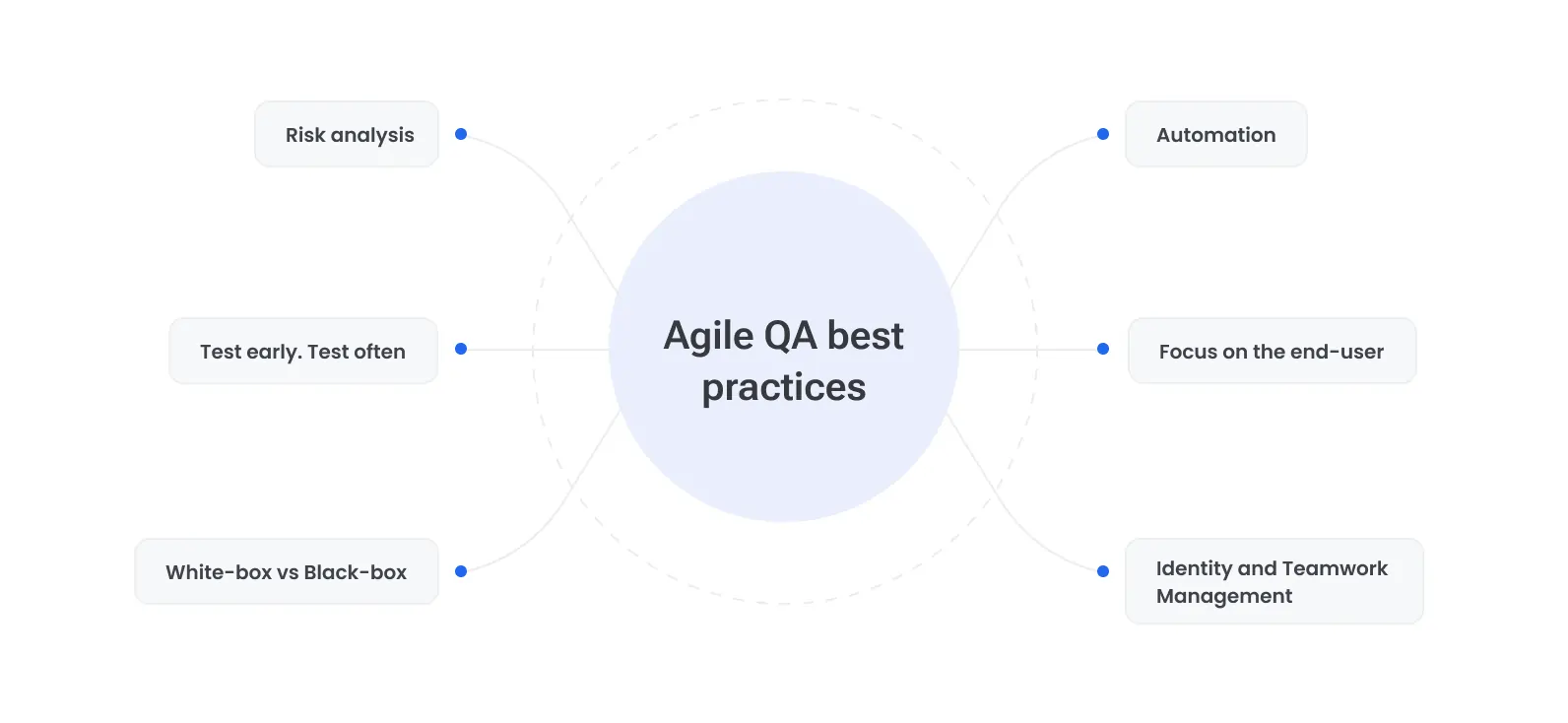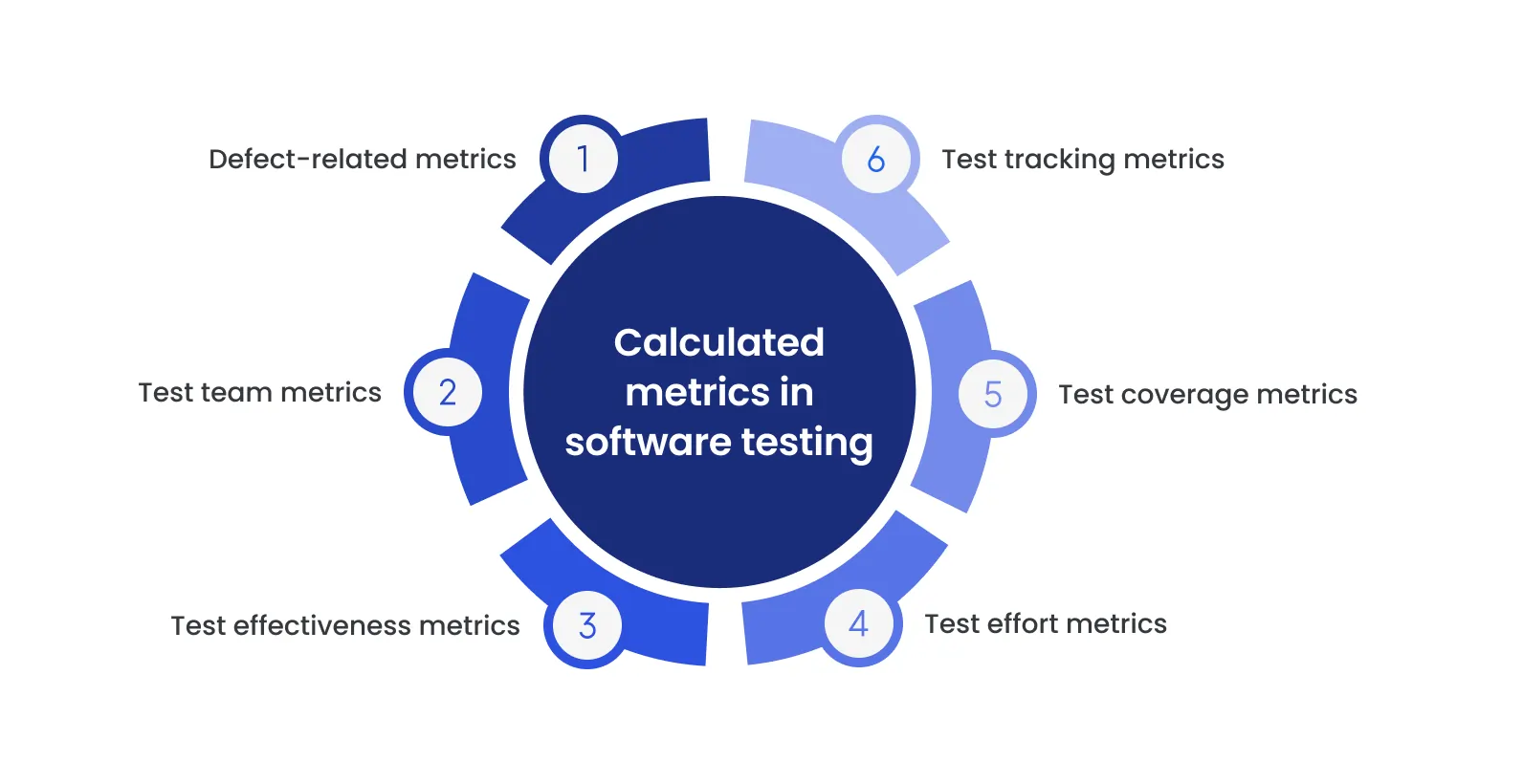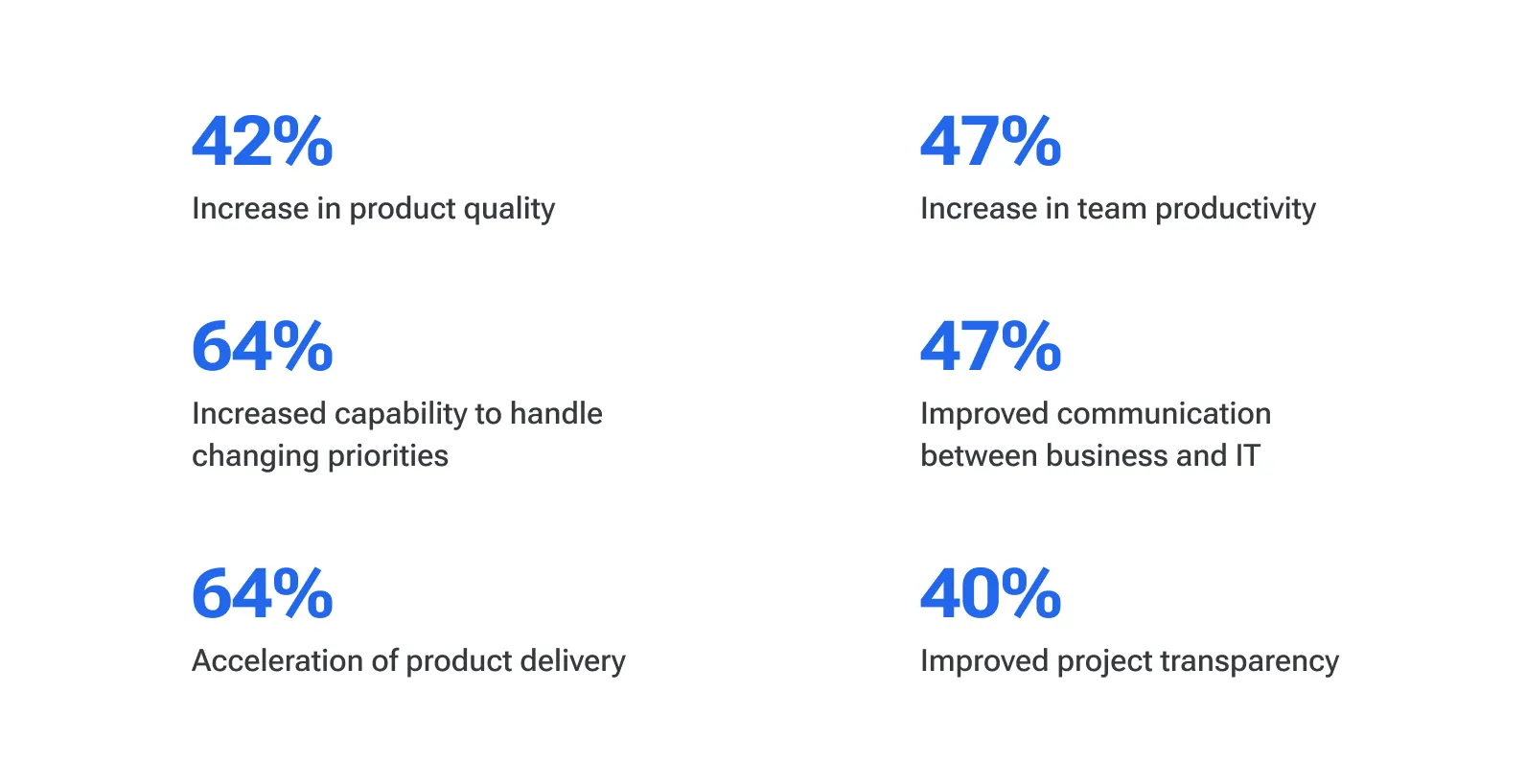Let’s face the truth – the IT world has gone Agile. The stats show that Agile adoption has already reached 86%. Tech companies striving to stay ahead heavily rely on Agile software development methodology. Yet, using Agile development with traditional testing is like racing a McLaren on budget tires – you're doomed to failure. Testing should also be agile to ensure the desired speed, adaptability, and quality.
Agile testing is more than just a part of the SDLC – it’s a strategic enabler that accelerates releases, optimizes resources, cuts costs, mitigates risks, and increases user satisfaction.
Agile testing manifesto: How Agile QA impacts your business
In the dynamic tech environment, testing can’t be a roadblock – it must be a catalyst for innovation. So, how to implement agile software testing? Let’s review common workflows, best practices, and key metrics to collect and analyze.
Testing cycle in Agile
Based on core Agile principles, including iterativeness and continuous improvement, the Agile testing cycle is ongoing, and its phases are repeated in each new iteration.

Here’s how it works in the real world:
Phase 1: Planning
The QA process in Agile starts with reviewing a product backlog to understand upcoming features, user stories, and requirements. QA engineers make sure that user stories are clear, testable, and well-defined, as well as help a team determine acceptance criteria. Also, they work on a test strategy, deciding how the features will be tested, which tools and environments will be used, and how much time the testing tasks will take.
Key points:
Aligning with developers and product owners on test coverage expectations.
Identifying potential risks and dependencies.
Defining the level of test automation required for the iteration.
Identifying requirements for test environments and data.
Phase 2: Test design
Depending on the goals of the iteration, available test cases are updated if needed, and new ones are created to cover each new user story. The focus is on expected behaviors and edge cases. Additionally, a ready-to-work dedicated QA team generates relevant and well-structured test data for positive and negative test scenarios and boundary conditions.
Key points:
Creating and updating test cases
Ensuring traceability between the test cases and user stories.
Prioritizing the test cases based on risk and business impact.
Establishing criteria for test automation feasibility.
Generating test data
Setting up test environments
Phase 3: Test execution
At this stage, QA engineers dive into testing itself. While repetitive tests are usually tackled through automation, more complex test scenarios are checked manually. It’s worth noting that in Agile testing, continuous testing is one of the best practices. Integrated into CI/CD pipelines, automated tests are continuously run, providing instant feedback to any committed code change. Performance, security, and usability tests are executed in the end, after functional tests. All bugs detected throughout testing are immediately logged and prioritized so that developers can fix them within the same iteration.
Key points:
Running manual and automated tests.
Monitoring and analyzing test results to detect patterns in failures.
Communicating issues immediately to developers for faster resolution.
Phase 4: Review
Along with other team members, QA engineers showcase completed user stories and validated features to stakeholders and ensure they meet the previously defined acceptance criteria that include both functional and non-functional requirements. Any last-minute refinements or stakeholder feedback may be incorporated before the iteration wraps up.
Key points:
Verifying the alignment of test results with business and user expectations.
Documenting key learnings from the iteration to improve future testing.
Gathering feedback from stakeholders on test coverage and quality.
Ensuring all reported defects are addressed or scheduled for fixes.
Phase 5: Retrospective
In the retrospective phase, QA engineers reflect on the iteration. They discuss what went well and what didn’t, identifying areas for improvement. The goal is to refine QA processes, strategies, tools, and collaboration techniques for future iterations. Managed testing services in this case is a great option to take the load off in-house QA.
Key points:
Reviewing QA process efficiency and identifying bottlenecks.
Discussing automation successes and potential improvements.
Adjusting test strategy based on lessons learned.
Best practices for Agile software quality assurance
Agile development is rapid – blink and the next iteration is already underway. To keep quality on track without delays, Agile teams rely on best practices that make testing as fast and flexible as the development process itself.

Here are some key agile testing practices to embrace for QA:
Shift-left testing
This approach suggests engaging testers as early as possible – ideally at backlog refinement. This enables the identification and resolution of issues before they turn into a real headache for the whole team. Importantly, in Agile, testing isn’t just early but also frequent, with automated and manual tests running at various stages of development to maintain high product quality within each iteration.
Test automation
While manual testing certainly remains essential for exploratory, usability, and complex test scenarios, repetitive and time-consuming tests, like regression or smoke tests, tend to be automated. In essence, automation is one of the core pillars of Agile testing that helps teams save time and ensure reliability.
Continuous testing
To ensure top-notch quality and waste no time, Agile testing implements non-stop checks through continuous testing. Automated testing as a service, integrated into CI/CD pipelines, runs continuously, providing immediate feedback on every code change – like a watchdog that never sleeps. This reduces regression risks, maintains code quality, and significantly accelerates releases.
Risk-based testing
When packing for a trip, we prioritize the essentials over things we might need. The same principle applies in Agile testing. Not all software features require the same level of testing. Prioritize test efforts based on risk, impact, and business value to ensure that critical functionalities receive the most thorough validation while keeping the QA process efficient and fast.
Collaborative testing
In Agile, all team members contribute to product quality and success. Therefore, the practice of paired testing, when a tester and a developer work together on the same QA task, is common in Agile teams. It accelerates issue detection, fosters knowledge sharing, and improves collaboration. A product owner or BA can also join the developer and tester to align expectations, clarify requirements, and define clear acceptance criteria, ensuring that everyone understands what needs to be built and tested. This practice has a fun name: "three amigos session".
Lightweight and maintainable test suites
Bloated test suites that take ages to run are a no-go in Agile testing. Testers should regularly clean up their test suites, removing obsolete and redundant test scripts. This measure ensures that automated tests run efficiently without creating bottlenecks in CI/CD pipelines.
Continuous QA process refinement
Agile is all about ongoing improvement, qa engineers should regularly review and refine the QA processes to ensure they’re running at peak efficiency. This could mean tweaking test strategies, adjusting automation workflows, or improving communication between team members. The goal is to eliminate inefficiencies, adapt to evolving project needs, and make sure that the testing process is in line with the overall team objectives.
Key QA metrics in Agile
Regular collection and analysis of Agile project management metrics provide valuable insights into the efficacy of the Agile QA process.

To spot areas that need improvement and determine where extra effort is needed, QA engineers track a variety of metrics, including the following:
Test coverage
A well-known but super important metric is test coverage, which is the percentage of code or features covered by test cases. Agile test teams do their best to reach high test coverage to ensure comprehensive validation. The high test coverage lowers the chances of bugs going unnoticed.
Pass/fail rate
This is the ratio of passed versus failed test cases. This metric helps teams monitor software stability during each iteration. If the rate is high, the build is far from being stable.
Defect density
This metric measures the number of bugs found per software module or feature. As a result, QA engineers can pinpoint high-risk areas. A spike in defect density suggests that corresponding areas require deeper testing or a thorough core review.
Automated test coverage
It also makes sense to track the proportion of test cases that have been automated compared to those still executed manually. High automated test coverage indicates high effectiveness, reduced manual work, and short feedback loops. Yet, it is worth mentioning that not everything can and actually should be automated. Agile teams apply automation only where it’s relevant.
Flaky test rate
Flakiness is one of the main troubles faced in automated testing. Flaky tests provide inconsistent results – sometimes passing, sometimes failing – while no changes have been made to the code. A high number of flaky tests slows down development, shatters confidence in automated testing, and leads to additional debugging efforts. By instantly detecting and fixing flaky tests, QA engineers increase the reliability of test results and reduce disruptions in CI/CD pipelines.
Test execution time
Short testing cycles are crucial for maintaining Agile speed. Therefore, the time taken to run all the test cases is measured in every iteration. Faster testing results in faster feedback, ensuring rapid development without sacrificing quality.
Defect leakage
This metric counts the number of defects that were overlooked during testing and sneaked into production, where they were found later. With its help, teams assess the effectiveness of the QA process in catching critical issues before deployment.
User sentiment
This metric differs from all the rest as it focuses not on the technical or operational nuances but on how real users perceive the product’s quality, stability, and usability. It assesses the human experience – what users actually feel when interacting with the software. Such real-world feedback helps QA teams spot previously undetected usability issues and make improvements in the following iterations.
Benefits businesses yield from the Agile QA process
So, you’ve set up an Agile QA process and implemented Agile best practices. What has your business gained from this? What are the advantages of Agile testing services? When done properly, Agile QA brings numerous benefits to your business. Here are some of them:
Enhanced product quality
What is the main goal of Agile testing? Obviously, excellent product quality. While many aspects of Agile testing contribute to this, two stand out. The first one is test automation, which enables test frequency and accuracy. The second one is the culture of shared responsibility, according to which everyone on the team is accountable for product quality. Thanks to these two factors, businesses are empowered to rock the market with groundbreaking software.
Cost reduction
One of the most prominent advantages of Agile testing is cost reduction. Since QA engineers are engaged early in the process, many bugs are caught in the initial development stages – even during requirement analysis. This lets businesses significantly cut costs on last-stage bug fixing. By nipping problems in the bud, businesses save a lot of money – those who know, know.
Greater adaptability
Since Agile QA aims to be as flexible as possible and quickly adjust to new priorities without disrupting the entire development cycle, businesses can rapidly incorporate user feedback or respond to market changes. This adaptability is crucial for meeting users’ demands and seizing new business opportunities.
Shorter time to market
Thanks to automation and continuous testing, testing cycles in Agile are rather short, which enables more frequent releases. Consequently, businesses launch new features and updates faster, increasing customer satisfaction and capitalizing on new market opportunities. This ability to deliver software quickly is a major competitive advantage.
Higher customer satisfaction
Happy clients are the key ingredient in the recipe for success. Agile QA services ensure outstanding quality and frequent releases, allowing businesses to quickly integrate feedback from customers and stakeholders. With software that evolves on an ongoing basis to meet real-world needs, businesses easily gain customer loyalty. This, in turn, reinforces their reputation as well as drives revenue.
The benefits of Agile testing are impressive and have a significant impact on business growth. Need more proof? These numbers reveal how Agile approach adaptation can transform your business:

How to test in Agile successfully?
Before wrapping up, we’d like to share with you some extra tips on how to ensure successful Agile testing. Our first piece of advice is to foster close communication and shared accountability. Engage QA engineers in all Agile ceremonies, be it stand-ups, sprint planning, or sprint retrospectives, to enable them to actively discuss quality assurance risks, troubles, or suggestions. This practice strengthens knowledge sharing within the team, helping developers, testers, and product owners stay aligned on QA goals. When quality becomes a shared responsibility rather than just the QA engineers’ function, the entire team works together to build a more reliable product.
Also, keep the right balance between automated and manual testing. While the former is of great help with repetitive, data-driven, and time-consuming tests, there are a variety of test scenarios that require human expertise and creativity. Take your time for exploratory testing that helps to check new edge cases and detect hidden bugs by simulating real-world user behaviors.
Finally, always stay user-focused. After all, everything you do is for the benefit of end users. So, test your software from the end-user perspective to ensure a seamless and intuitive experience. However, that’s not enough – regularly collect and incorporate user feedback into both development and testing. Understanding real-world usage patterns helps refine software quality and align it with user expectations.
Conclusion
It is a well-known fact that traditional testing has become obsolete. In the modern dynamic setting, Agile testing is the go-to. Focused on automation, continuous testing, close collaboration, a shift-left approach, adaptability, and continuous improvement, it lets businesses ensure excellent quality, deliver software updates frequently, respond to new market demands instantly, build strong customer loyalty, and reduce costs.
If you want to thrive, investing in efficient Agile testing is a must. Lacking expertise or the right talent? Chin up – DeviQA’s professional Agile testing services are here to guide you through the entire process. Let us know your QA challenges, and we’ll tackle them with well-established Agile testing.
